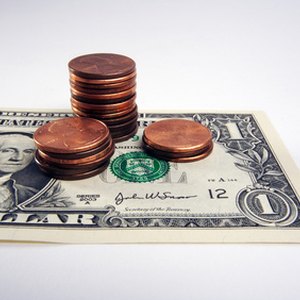
Compound interest refers to the interest that an account accumulates over more than one compounding period. The interest that gets added to the account after the first compounding period begins to accrue more interest itself, increasing the interest paid over future compounding periods. To calculate compounding interest, you need to know the periodic interest rate, the amount of money in the account and the number of periods the money remains in the account.
Convert the periodic rate into a decimal from a percentage by multiplying it by 1/100. For example, if the periodic rate equals 1.05 percent, you would multiply 1.05 by 1/100 to get 0.0105.
Add 1 to the periodic rate expressed as a decimal. In this example, you would add 1 to 0.0105 to get 1.0105.
Determine the number of periods the money will accrue interest. For example, if the periodic rate equals the monthly rate, and you leave the money in the account for three years, you would be leaving the money in the account for 36 periods.
Multiply the result from Step 2 by itself C number of times, where C is the number of compounding periods the money will be left in the account from Step 3. In this example, you would multiply 1.0105 by itself 36 times to get 1.456489784.
Subtract 1 from the result from Step 4 to calculate the overall percentage increase expressed as a decimal. In this example, you would subtract 1 from 1.456489784 to get 0.456489784.
Multiply the overall percentage increase by the amount originally invested in the account to find the total interest. Finishing this example, if the account started with $11,000, you would multiply 0.456489784 by $11,000 to find that $5,021.39 of interest would have accrued.
References
- DePaul University: Compound Interest Formula
- University of Arizona: Compound Interest and APY Calculations
- Experian. "What Is APR and How Does It Affect Me?" Accessed Sept. 15, 2020.
- Inc. “Why Einstein Considered Compound Interest the Most Powerful Force in the Universe.” Accessed Sept. 15, 2020.
- Corporate Finance Institute. “What is the Compound Interest Formula?” Accessed Sept. 15, 2020.
- Corporate Finance Institute. “What is the Annual Percentage Yield?” Accessed Sept. 15, 2020.
- Office of the Comptroller of the Currency. "Truth in Lending." Accessed Sept. 15, 2020.
- American Express. "APY vs. APR: The Basics About How Interest Is Calculated." Accessed Sept. 15, 2020.
Writer Bio
Based in the Kansas City area, Mike specializes in personal finance and business topics. He has been writing since 2009 and has been published by "Quicken," "TurboTax," and "The Motley Fool."

